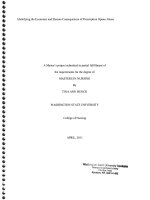Neurokinetics the dynamics of neurobiology in vivo
Bạn đang xem bản rút gọn của tài liệu. Xem và tải ngay bản đầy đủ của tài liệu tại đây (11.81 MB, 360 trang )
Neurokinetics
Albert Gjedde
William R. Bauer
Dean F. Wong
Neurokinetics
The Dynamics of Neurobiology In Vivo
ABC
Albert Gjedde
Copenhagen University
Department of Neuroscience
and Pharmacology
3 Blegdamsvej
2200 Copenhagen N
Denmark
William R. Bauer
2053 Old Washington Road
21157 Westminster Maryland
USA
Dean F. Wong
Johns Hopkins Medical Institutions
JHOC Bldg room 3245
601 N. Caroline St.
21287 Baltimore Maryland
USA
ISBN 978-1-4419-7408-2 e-ISBN 978-1-4419-7409-9
DOI 10.1007/978-1-4419-7409-9
Springer New York Dordrecht Heidelberg London
Library of Congress Control Number: 2010937988
c
Springer Science+Business Media, LLC 2011
All rights reserved. This work may not be translated or copied in whole or in part without the written
permission of the publisher (Springer Science+Business Media, LLC, 233 Spring Street, New York,
NY 10013, USA), except for brief excerpts in connection with reviews or scholarly analysis. Use in
connection with any form of information storage and retrieval, electronic adaptation, computer software,
or by similar or dissimilar methodology now known or hereafter developed is forbidden.
The use in this publication of trade names, trademarks, service marks, and similar terms, even if they are
not identified as such, is not to be taken as an expression of opinion as to whether or not they are subject
to proprietary rights.
Printed on acid-free paper
Springer is part of Springer Science+Business Media (www.springer.com)
Preface
Attempts to understand physiological processes by quantification and interpretation
of observations made in vivo have challenged the biological and physical sciences
for centuries. From the earliest physiological experiments in living organisms, the
joint approaches of biology and physics to the discovery of these processes, from
cells to humans, have yielded profound insights and have had a major impact on
our understanding of all organ systems and on the modern practice of medicine as
a whole. The work of Helmholz (1821–1894) is an example of the early merger of
physics and biology that ultimately led to the most recent formulation of a systems
biology approach that is no less than the quest for complete quantification of the
dynamic processes of entire organismsand organs in health and disease, for example
in the shape of the Physiome Project of Bassingthwaighte (2000) and the Blue Brain
Project of Markram (2006).
In this compendium, we focus on the dynamics of brain physiology in vivo from
the perspective of the methods of tracer kinetics (neurokinetics). Applications of
neurokinetics seek to measure the processes that take place in the tissue without dis-
turbing these processes, and subsequently to map these measurements onto images
of brain tissue.
Applications of physiological kinetics (including neurokinetics) use “indicators”
or markers, ranging from the dyes introduced at the dawn of experimental physiol-
ogy, via stable (nonradioactive) or unstable (radioactive) isotopes introduced in the
1960s, to the most recent methods of in vivo imaging of optical, magnetic resonance
(MR), and magnetic field (MEG) signals for visualization and detection.
The authors dedicate this book to the consolidation of many neurokinetic con-
cepts with roots in the neurophysiology of the mid-20th century with the state-of-
the-art imaging and parametric mapping methods of the first decade of the 21st
century.
In one of the earliest attempts to quantify the pharmacokinetics of a substance
in blood, Widmark (1919) followed the concentration of a single dose of ace-
tone injected into the bloodstream. Widmark and others subsequently examined a
number of so-called “model” configurations, including the first account of a one-
compartment open model (Widmark and Tandberg 1924) and the later extension to
two compartments (Gehlen 1933).
v
vi Preface
Models of Living Systems
Apostel (1960) described a model of a living system as an artificial system that
“simulates a biological system. The kinetic analysis of the model (which usually
describes a dynamic process) tests the validity of the model of the combined kinetic
behavior of the elements of each compartment. The model provides the basis for
prediction of subsequent behavior. Thus, the model is the mathematical expression
of the biological system, and the mathematical analysis is the test of predictions
generated by the hypothesis.”
Statistical hypothesis testing often is used to judge whether a model is appro-
priate or not. The model is defined by operational equations that yield a dependent
variable for each set of independent variables. The statistical evaluation of the ki-
netic analysis cannot of itself establish the truth of the model, which is why it is more
accurate to describe the validated model as “not yet rejected” and therefore still po-
tentially useful to the solution of a given problem. Likewise, the answers provided
by the operational equation are only “consistent” with the experimental or clinical
observations. For this reason, it is important to identify those situations in which the
model is rejected by the chosen compartmental analysis, e.g., by application of a
criterion of information content (Akaike 1974) in which statistical goodness of fit is
balanced against the number of parameters fitted.
Kinetics and Molecular Biology
The purpose of kinetic analysis of living matter is to obtain quantitative measures
of the rate of molecular reactions. Quantitative approaches were uncommon in biol-
ogy and medicine prior to the second half of the nineteenth century and only slowly
gained ground against traditionally qualitative considerations. The competition be-
tween quantitative and qualitative perspectives is felt even today.
The struggle reflects the changing views of disease in the medical sciences in
which a disorder originally was thought to represent a major imbalance among qual-
itatively different matters of nature and life, including the four elements (water, air,
fire, and earth) and the four cardinal fluids (blood, phlegm, yellow bile, and black
bile).
This imbalance no longer is a valid consideration. The imbalance underlying dis-
ease appears to follow minute but specific errors which are now known to create
the effects of disease by turning open thermodynamic systems implemented in bio-
chemical and physiological compartments into closed systems that must ultimately
fail because entropy rises in closed systems as order is replaced by disorder. Thus,
it is a fundamental observation that truly closed systems eventually become incom-
patible with life.
The concept of imbalance is quantitative, as is the injunction of living matter
to respond to exigencies with moderation. Thus, measurement is the modern prac-
tice, although it is tied to an increasing understanding of the limits of certainty.
Preface vii
Competing with this understanding is the rise of information technology, according
to which the quantitative properties of the components of living systems could be
less important, implying that only their structural relations are informative. Thus,
there is a current sense that the tide of scientific philosophy is returning in the direc-
tion of the holistic and qualitative. Only the practice of meticulous kinetic analysis
can correct this misunderstanding.
Kinetics and Genomics
Living matter is distinguished from nonliving matter primarily by its ability to
maintain steady-states of incredibly complex molecular compartments far from ther-
modynamic equilibrium. The information enabling the realization of this enormous
potential resides in a remarkably inert and robust molecule called deoxy-ribonucleic
acid (DNA). However, the DNA molecule itself does nothing; its entire and com-
pletely passive role is to be decoded by a machine or mechanism. Its power to elicit
action derives from the ability of other molecules in living tissue to read its instruc-
tions at the right time and place.
As the decoder must understand the message of at least the opening sections of
the manual (the rest can be learned in due course), in advance of the decoding, the
fundamental goal of metabolite and tracer kinetic analysis in biology and medicine
is to describe and quantify the processes in their entirety from the conception to the
termination of the organism. For example, it is estimated that at the peak of neu-
ronal proliferation during human gestation, as many as 250,000 new brain cells of
identical composition are created every minute. Yet, metabolite concentrations ev-
erywhere remain inside carefully regulated limits. A snapshot of any one cell would
produce an unremarkable image; only the proper tracer kinetic analysis could reveal
the astounding dynamics of the metabolite fluxes contributing to this development.
Kinetics and Proteomics
The rate of molecular reactions typically is constrained by proteins. An important
measure of health is steady-state, in which proteins maintain the concentrations of
metabolites while the molecular fluxes adjust to local and global requirements. Most
importantly, the composition of living matter remains constant in steady-state (hence
the name) and a momentary glimpse reveals none of the dynamics of the underlying
molecular fluxes. The further the steady-state is from a state of equilibrium, the
greater is the work required to maintain it, and the greater are the fluxes controlled
by the proteins. Only a few processes are near equilibrium and they typically do not
interfere with the regulation of the important molecular fluxes of living matter.
viii Preface
When concentrations normally do not change outside tightly controlled limits,
past attempts to understand the underlying dynamics by perturbing a system often
removed the system from its normal state and sometimes failed to specifically reveal
the normal dynamic properties of its kinetics. The introduction of suitably flagged
(“labeled”) and hence identifiable representatives of the native molecules, called
“tracers,” accomplishes a minimal perturbation without disturbing the steady-state
of the system, provided the quantity of tracer is kept too low to change the system’s
properties. Methods of doing just that form the core of the tracer kinetic analysis of
biological processes.
Role of Tracers in the Study of Models
A physiological/biological process to be studied is often exposed by means of a
tracer (not always radioactive), that is a marker of a native molecule relevant to the
process that can be detected by an instrument, e.g., radioactive counting or light or
magnetic measurement. The tracer must be present in such low mass/quantity that
the characteristics of the processes in which the tracer participates do not change
(e.g., does not compete with the endogenous processes, in the case of neuroreceptor
imaging the tracer does not occupy significant receptor sites to notably compete
with endogenous neurotransmitters).
The purpose of this requirement is to rule out the departure from steady-state
that would otherwise cause the concentrations of native molecules to change as
functions of time. The departure of the native system from steady-state would
in turn interfere with the first-order relaxation of tracer compartments, discussed
in the text.
Organisms and organs are collections of cells that internalize the tracer in dif-
ferent ways according to the physical and chemical properties of the tracer, and the
biochemical and physiological properties of the cells. A physiological model can
be formulated as a collection of compartments that represent the different states of
the tracer and its metabolites. Strictly speaking, the compartments have no formal
relation to the structure of the target organ, except to the extent that the anatomy de-
lineates the processes in which the tracer or its metabolites participate (e.g., a tracer
may bind to an active site as a receptor or transport mechanism when its structure
fits the receptor or transporter site in the right chemical fashion). For this reason the
model may be much simpler than that of the actual native system and still be a valid
portrayal of the kinetic behavior of the tracer. In other words, the model is of the
tracer, not of the native system. Often, compartments reflect the biochemistry of an
organ and refer to quantities of tracer or its metabolites that need not be confined to
separate subdivisions of the organ.
Sheppard (1948) defined compartments as quantities of a tracer or its metabolites,
the concentrations of which remain the same everywhere, each quantity having a
single state that may vary in time but not in space. A quantity is the number of
Preface ix
molecules in units of moles (mol), 1 mol holding 6:0225 10
23
atoms or particles.
Thus, initially, a tracer is neither in a steady-state, nor in equilibrium. However,
there are other noncompartmental approaches to physiological quantification that
can also be employed (see text).
Role of Models as Interpreters of Biological Dynamics
When researchers interpret processes of physiology and pathophysiology by means
of tracers or other marker tools, they examine the results with specific methods that
include biochemical measures (e.g., mass spectrometry and radioactivity counting)
or external recording in vivo (e.g., positron or single photon emission tomography
[PET or SPECT]). There is rather a tendency (often naive) to search for a tracer act-
ing as a “magic bullet” that provides a picture of the entire process by biochemical
measures or external imaging of a subject. In the example of external imaging, wait-
ing a specified time after intravenous injection typically occurs in the clinical setting
of recording of static images for evaluation of, say, heart or bone in conditions in
need of a diagnosis.
However, when attempts are made to understand and quantify a physiological
approach with the greatest scientific rigor, evaluation of the full dynamic process
prior to a steady-state is necessary, even when mathematical simplifications are later
found to be acceptable. This necessity usually includes not only the brain kinetics of
the tracer but also the input record which reflects the dynamic history of the tracer
itself, circulating from the injection site to the planned target (e.g., the blood volume
spaces at the blood–brain barrier interface).
This book is also dedicated to the understanding of the underlying principles of
kinetic properties of dynamic biological processes of brain physiology, the so-called
“neurokinetics.”
Approaches to Physiological Modeling
Physiological processes are best determined by mathematical descriptions which
then are subject to the well established rules of computation of the physical and
chemical sciences rather than any qualitative approach that is limited and can lead
to erroneous extrapolations beyond the actual empirical data.
Compartmental Modeling
The most common approach to the in vivo quantification of dynamic brain processes
(as networks of complex chemical systems) is that of compartmental modeling. This
x Preface
approach divides the physiological processes into definable units. In the case of
brain images, it depends at a minimum on records of the tracer input function (usu-
ally from plasma or whole-blood samples) and one or more brain compartments .
The assumptions and principles are outlined in Chaps. 1 and 2.
Non-Compartmental Modeling
A presentation of noncompartmental models is beyond the scope of this book. How-
ever, there are early examples of attempts to quantify physiological properties such
as blood flow or blood volume, as in the case of the indicator dilution method re-
viewed by Zierler (2000).
Distributed models attempt to account for spatial gradients in concentrations
(e.g., in blood-tissue exchange) in contrast to compartmental models that depend
on concentration averages within each compartment (Kuikka et al. 1991).
In the compartmental models to be discussed in the following chapters, the
usual assumption is the existence of homogeneous and fully stirred compart-
ments. There are attempts at modeling that directly address this inhomogeneity
with so-called “distributed” models, such as in the case of myocardial blood
flow estimation, including fractal analysis, a branch of mathematical analysis
(Qian and Bassingthwaighte 2000). Unfortunately, little progress has been made
in the field of quantification of dynamic brain processes with noncompartmental
models (one attempt was made by Wong and Gjedde in 1996), limited in part by the
poorly resolved temporal and spatial sampling of brain images, compared to data
obtained from cardiovascular and other systems, perhaps in part due to the more
invasive tools used in the study of the latter.
Some distributed models have been proposed for use with PET and ex-
ternal imaging as in the measurement of oxygen consumption (Deussen and
Bassingthwaighte 1996), with special attention to small tissue regions (Li et al.
1997). However, the majority of these applications used invasive approaches to
imaging, with direct measurement of the tracer concentrations.
Nomenclature
The nomenclature adopted in this books originated in publications spanning more
than 35 years. Other nomenclatures have been presented in more recent attempts
to reach consensus that we intend to evaluate in future editions, as discussed in
the Glossary section of this book where all terms are explained. In this edition, we
chose to retain the nomenclature as originally published while we wait for further
refinement of the current consensus reports.
Preface xi
Acknowledgements
We wish to thank the mentors and teachers who introduced these topics to us in
a manner that we could understand, including Ludvik Bass of Australia, Christian
Crone of Denmark, and Clifford Patlak, Fred Plum, Louis Sokoloff, and Henry N.
Wagner, Jr., of the United States of America. We also thank Arvid Carlsson and Paul
Greengard for encouragement and advice, our contemporaries Vin Cunningham,
Mike Kuhar, and Sol Snyder for conveying the fundamentals of receptor action,
our collaborators Chris Bailey, Per Borghammer, Peter Brust, Paul Cumming,
Alain Dagher, Doris Doudet, Alan Evans, Gerhard Gr¨under, Anker J´on Hansen,
Hiroto Kuwabara, Sean Marrett, Anders Rodell, Oliver Rousset, Manou Vafaee,
and Yun Zhou for continuous challenges in this discipline, and not the least Rodger
Parker who tried to keep us on a most rigorous course for many years. In addition,
we wish to thank the funding agencies that over the years enabled the work that is
summarized in these pages, as listed in the papers that we cite.
Contents
1 Introduction to Compartmental Analysis 1
1.1 Concept of Compartments 1
1.1.1 Living Systems 1
1.1.2 Thermodynamics and Entropy 3
1.1.3 Fundamental Solution 6
1.1.4 Limitations of Compartmental Analysis 6
1.2 Single Tissue Compartment Analysis 7
1.3 Two Tissue Compartment Analysis 9
1.3.1 Compartmental Assumptions 9
1.3.2 Combined Compartments 12
1.3.3 Arteries and Veins 13
1.4 Three Tissue Compartment Analysis 14
1.4.1 Compartmental Assumptions 15
1.4.2 Combined Compartments 20
2 Fundamentals of Compartmental Kinetics 23
2.1 Definition of Relaxation Constants 23
2.1.1 Single Compartment 24
2.1.2 Two Compartments 25
2.1.3 Two Compartments with Sink 28
2.1.4 Three Compartments 30
2.1.5 Three Compartments with Sink 34
2.1.6 Four or More Compartments 36
2.1.7 Multiple Compartments in Series and in Parallel 39
2.2 Interpretation of Relaxation Constants 42
2.2.1 Flow 42
2.2.2 Passive Diffusion 43
2.2.3 Properties of Delivery Compartment 49
2.2.4 Protein–Ligand Interaction 56
2.2.5 Receptor Binding 61
xiii
xiv Contents
2.2.6 Facilitated Diffusion 63
2.2.7 Enzymatic Reactions 67
2.3 Determination of Relaxation Constants 70
2.3.1 Stimulus-Response Relations 70
2.3.2 Regression Analysis 71
2.3.3 Deconvolution of Response Function by Differentiation 73
2.3.4 Deconvolution by Temporal Transformation 75
2.3.5 Deconvolution of Response Function by Linearization 86
2.4 Application of Relaxation Constants 91
2.4.1 Peroxidation 91
2.4.2 Dopaminergic Neurotransmission 91
3 Analysis of Neuroreceptor Binding In Vivo 103
3.1 The Receptor Concept 103
3.2 The Compartment Concept 105
3.2.1 Compartmental Analysis 105
3.2.2 The Basic Equation 106
3.2.3 The Basic Solution 107
3.3 Two-Compartment (Permeability) Analysis 108
3.3.1 Analysis of K
1
and k
2
108
3.3.2 Physiological Definitions of K
1
and k
2
110
3.4 Three-Compartment (Binding) Analysis 111
3.4.1 Analysis of k
3
and k
4
111
3.4.2 Molecular Definitions of k
3
and k
4
115
3.4.3 Inhibition 118
3.4.4 The Problem of Solubility and Nonspecific Binding 120
3.4.5 The Problem of Labeled Metabolites 122
3.5 In Vivo Analysis of Binding 122
3.5.1 Irreversible Binding: Determination of k
3
122
3.5.2 Reversible Binding: Determination of Binding
Potential (p
B
) 124
3.5.3 Equilibrium Analysis: Determination of B
max
and K
D
126
4 Neuroreceptor Mapping In Vivo: Monoamines 131
4.1 Introduction 131
4.2 Monoaminergic Neurotransmission 131
4.3 Methods of Neuroreceptor Mapping 133
4.3.1 Tracers of Monoaminergic Neurotransmission 136
4.3.2 Pharmacokinetics of Monoaminergic Neurotransmission 140
4.4 Altered Monoaminergic Neurotransmission 145
4.4.1 Dopamine 146
4.4.2 Serotonin 149
4.4.3 Design of Monoaminergic Drugs 151
4.5 Conclusions 151
Contents xv
5 Blood–Brain Transfer and Metabolism of Oxygen 153
5.1 Introduction 153
5.2 Blood–Brain Transfer of Oxygen 154
5.2.1 Capillary Model of Oxygen Transfer 154
5.2.2 Compartment Model of Oxygen Transfer 157
5.3 Oxygen in Brain Tissue 159
5.3.1 Cytochrome Oxidation 159
5.3.2 Mitochondrial Oxygen Tension 161
5.4 Flow-Metabolism Coupling of Oxygen 165
5.5 Limits to Oxygen Supply 167
5.5.1 Distributed Model of Insufficient Oxygen Delivery 168
5.5.2 Compartment Model of Insufficient Oxygen Delivery 171
5.6 Experimental Results 172
5.6.1 Brain Tissue and Mitochondrial Oxygen Tensions 172
5.6.2 Flow-Metabolism Coupling 173
5.6.3 Ischemic Limits of Oxygen Diffusibility 176
6 Blood–Brain Glucose Transfer 177
6.1 Brief History 177
6.2 Brain Endothelial Glucose Transporter 178
6.2.1 Molecular Biology 178
6.2.2 Molecular Kinetics 180
6.2.3 Structural Requirements of Glucose Transport 181
6.3 Theory of Blood–Brain Glucose Transfer 182
6.3.1 Apparent Permeability and Flux 183
6.3.2 Facilitated Diffusion 186
6.3.3 Multiple Membranes 189
6.4 Evidence of Blood–Brain Glucose Transfer 191
6.4.1 Methods 192
6.4.2 Normal Values in Awake Subjects 196
6.4.3 Acute Changes of Glucose Transport 201
6.4.4 Chronic Changes 206
7 Metabolism of Glucose 211
7.1 Basic Principles of Metabolism 211
7.1.1 Glycolysis 212
7.1.2 Oxidative Phosphorylation
214
7.1.3 Gluconeogenesis 214
7.1.4 Glycogenesis and Glycogenolysis 215
7.1.5 Pentose-Phosphate Pathway 215
7.2 Kinetics of Steady-State Glucose Metabolism 215
7.3 Kinetics of Deoxyglucose Metabolism 217
7.3.1 Irreversible Metabolism 219
7.3.2 Lumped Constant 220
7.3.3 Reversible Metabolism 221
xvi Contents
7.4 Operational Equations 224
7.4.1 Irreversible Metabolism of Deoxyglucose 224
7.4.2 Reversible Metabolism of Fluorodeoxyglucose 229
7.4.3 Metabolism of Tracer Glucose 231
7.5 Glucose Metabolic Rates 233
7.5.1 Lumped Constant Variability 235
7.5.2 Whole-Brain Glucose Consumption 237
7.5.3 Regional Brain Glucose Consumption 238
8 Neuroenergetics 241
8.1 Brain Work 241
8.2 Ion Homeostasis 242
8.3 Brain Energy Metabolism 244
8.3.1 Definition of Brain Activity Levels 244
8.3.2 Stages of Brain Metabolic Activity 246
8.4 Substrate Transport in Brain 248
8.4.1 Glucose Transport 248
8.4.2 Monocarboxylate Transport 249
8.4.3 Oxygen Transport 250
8.5 ATP Homeostasis 252
8.5.1 Hydrolysis of Phosphocreatine 253
8.5.2 Glycolysis 253
8.5.3 Oxidative Phosphorylation 256
8.6 Metabolic Compartmentation 259
8.6.1 Functional Properties of Neurons and Astrocytes 259
8.6.2 Metabolic Properties of Neurons and Astrocytes 260
8.7 Activation 265
8.7.1 Ion Homeostasis During Activation 266
8.7.2 Brain Energy Metabolism During Activation 267
8.7.3 Substrate Delivery During Activation 273
8.7.4 ATP Homeostasis During Activation 281
8.7.5 Metabolic Compartmentation During Activation 286
8.8 Conclusions 288
Glossary 291
References 301
Index 335
Chapter 1
Introduction to Compartmental Analysis
1.1 Concept of Compartments
1.1.1 Living Systems
In the context of compartmental analysis, a living organism can be described as
an open biological system existing in a steady-state far from thermodynamic equi-
librium. Thermodynamic equilibrium is a state in which no biological processes
can occur because there are no potential gradients to drive them; no differences
in mechanical potential to drive blood flow, in concentrations to drive diffusion, in
chemical potentials to drive metabolism, in electrical potentials to drive ions, and in
temperature to drive heat flow. Steady-state and thermodynamic equilibrium share
the characteristic that they are invariant in time. Thermodynamic equilibrium is also
invariant in space. The steady-state variance of constituent chemicals in space is
the focus of compartmental analysis. Spatial variance is assigned to the interfaces
between abstract compartments rather than to the living system as a whole. As the
compartments by this definition are in thermodynamic equilibrium internally, they
are incompatible with life but we choose to ignore this fundamental characteristic.
Compartmental analysis uses the principles of biophysics and mathematics to
determine the velocity of exchanges among the compartments (biochemical pro-
cesses) and the relative size of the individual compartments (biochemical pools) in
vivo, using tracer molecules, defined as markers that do not perturb the system.
During a medical study or biological experiment, the tracer and its metabo-
lites assume different states, each of which may be well defined but all of which
change and interact as functions of time. Eventually, one or more of these states
may reach the steady-state characteristic of the native system, though far from
thermodynamic equilibrium. This steady-state can be maintained only in thermo-
dynamically open systems. If energy is no longer provided or expended, potential
Adapted from Gjedde (1995a) Compartmental analysis. In: Principles of Nuclear Medicine, 2nd
edition, eds Wagner HNJr, Szabo Z, Buchanan JW. Saunders, Philadelphia, pp. 451–461, with
permission from Saunders, Philadelphia.
A. Gjedde et al., Neurokinetics: The Dynamics of Neurobiology In Vivo,
DOI 10.1007/978-1-4419-7409-9
1,
c
Springer Science+Business Media, LLC 2011
1
2 1 Introduction to Compartmental Analysis
gradients vanish, biological work can no longer occur, thermodynamic equilibrium
irreversibly replaces the steady-state, and life ceases to exist. Conversely, when a
tracer steady-state of thermodynamic nonequilibrium continues indefinitely, the sys-
tem turns over energy and, almost by definition, is alive.
When disease intervenes, living systems tend to move toward, and eventually
reach, thermodynamic equilibrium, and the individual compartments fuse. This
makes tracer kinetic analysis of compartments a useful tool in the characterization
of disease. The shift from the healthy steady-state provides both a motive for, and a
means of, compartmental analysis in vivo: Only limited information is available in
vitro, i.e., postmortem, because the important changes occur prior to death, and the
premortem changes define the disease.
Definition of Compartments as Tracer States
A compartment has a specific mathematical definition. A model is a set of compart-
ments that simulate a biological system. Compartmental analysis tests the validity
of the model of the combined kinetic behavior of the elements of each compart-
ment. The model provides the basis for prediction of subsequent behavior. Thus, the
model is the mathematical expression of the biological system, and the compart-
mental analysis is the test of predictions generated by the hypothesis.
As mentioned earlier, Sheppard (1948) defined compartments as quantities of a
tracer or its metabolites, the concentrations of which remain the same “everywhere,”
each quantity having a single state that may vary in time but not in space. A quantity
is the number of molecules in units of mol (6:0225 10
23
). Thus, initially, a tracer
is neither in a steady-state nor in thermodynamic equilibrium. Rescigno and Beck
(1972a, b) restricted Sheppard’s definition of a compartment to that of a tracer state
that varies in time only, according to the expression,
dm
dt
D j km; (1.1)
where m is the quantity (mol) of tracer that belongs to the compartment (i.e., has the
relevant state), k the relaxation (“rate”) constant, and j the flux of tracer molecules
into the compartment as a function of time. It follows from this definition that the
relaxation constant is given by the relationship,
k D
j
m
1
m
dm
dt
: (1.2)
At steady-state (dm=dt D 0), k is the turnover rate j=m, as derived later in (1.12).
The definition requires that the escape of tracer from the particular state (the “relax-
ation” of the state) be a first-order process. It depends on the process responsible for
the relaxation whether this requirement is met. One such process (diffusion) will be
examined later.
1
1
Note the convention that variables are indicated by lower case symbols, except for the relaxation
constants.
1.1 Concept of Compartments 3
1.1.2 Thermodynamics and Entropy
In most cases, the interfaces between compartments represent diffusion barriers such
as cell membranes or chemical reactions involving transporters, receptors, or en-
zymes. The processes can be spatially well-defined, for example when the diffusion
barrier or protein is associated with a cell membrane.
The tracer is subject to the same forces, or potential gradients, that drive the
native compartment. Thermodynamically, this “relaxation” results from the pro-
duction of entropy during the process. When the decay finally ceases, i.e., when
the “relaxation” is complete, there is maximum disorder within the system. The
potential loss of order enables the system to perform work, measured in units of
electrochemical “potential.”
The electrochemical potential (of the tracer) is established by the properties of
the tracer that enable it to perform work. These include the concentration for a given
diffusion coefficient or permeability, the electrical charge for a given electrical field,
the volume for a given pressure, the mass for a given gravitational field, and the
chemical structure, including the bonds that keep the structure together, for a given
chemical environment. Analysis of the speed of dissipation of the electrochemical
potential reveals the nature of the system in which the tracer state decays. A closed
system will generate entropy and perform work until all parts of the system have the
same relative potential of zero, i.e., until thermodynamic equilibrium is achieved.
At thermodynamic equilibrium, the potential varies neither in time, nor in space.
If the system is open, it may adopt a steady-state in which energy is supplied at a
rate exactly matched to the dissipation of the system’s potential; in that case, the
potential varies in space but not in time.
By definition, the tracer behaves in the opposite manner, i.e., it varies with time
rather than space. In reality, of course, the tracer varies both with time and in space
because it is neither at steady-state nor in thermodynamic equilibrium. To remove
the variance in space, the tracer is assigned artificially to pockets or compartments
that obey the basic compartmental assumption that tracer states are invariant in
space. With time, the tracer proceeds toward, but never reaches, thermodynamic
equilibrium in an open system. Instead, it may attain a secular equilibrium in which
the relative proportions of two or more quantities approach constants dictated by
the rate of escape from the system as a whole. Before the tracer’s secular equilib-
rium turns into thermodynamic equilibrium, the steady-state of the native system is
imposed on the tracer which finally becomes part of the system itself.
Equilibrium and Steady-State
Assuming there are N compartments, each with mass m
i
.t/, 1 Ä i Ä N ,the
following definitions hold.
Secular Equilibrium The masses, m
i
.t/, are said to be in secular equilibrium if they
remain in constant proportion, i.e., m
i
.t/=m
j
.t/ D constant for all 1 Ä i;j Ä N .
4 1 Introduction to Compartmental Analysis
Transient Equilibrium The ith compartment is said to be in transient equilibrium at
time t if dm
i
.t/=dt D 0 at time t.
Steady-State Thesystemissaidtobeinsteady-stateifdm
i
.t/=dt D 0,forall
1 Ä i Ä N and all t beyond a certain t
0
.
Equilibrium The term equilibrium, used without a qualifier, means the absence
of one or more potential gradients. With a qualifier, the term means absence of a
potential gradient of a specific type. For example, chemical equilibrium means the
absence of a gradient in chemical potential. Thermodynamic equilibrium refers to
the absence of potential gradients of any type.
Work being an integral of force over distance, the absence of a potential gradient
implies an inability to do work of the associated type. Thus, the absence of chemical
potential implies an inability to do chemical work. As thermodynamic equilibrium
is characterized by the absence of all potential gradients, it implies the inability to
do work of any type.
Diffusion
An example of a process that is subject to compartmental analysis is simple dif-
fusion. Diffusion results in the production of entropy such that the system is less
orderly at the end of the diffusion than at the onset. Diffusion dissipates the electro-
chemical potential () which is a function of several factors,
D
o
C RT ln c C zF ; (1.3)
where
o
is the standard chemical potential, c the concentration (activity), z the
number of charges per particle, F Faraday’s constant, and its electric potential.
Electrochemical equilibrium is present when the ratio defining the partition coeffi-
cient D c
2
=c
1
D ˛
2
=˛
1
equals the value of the term e
.
o
zF /
where c
1
and
c
2
are the concentrations and ˛
1
and ˛
2
are the solubilities, relative to water, in two
adjoining media.
The speed with which secular equilibrium is reached is an important indicator of
the composition of the tissue. The diffusion velocity is the product of the mobility
of the particles and the force or potential gradient,
g
@
@x
Dg
Â
RT
c
@c
@x
C zF
@
@x
Ã
; (1.4)
where g is the mobility (inverse frictional resistance) and @=@x the gradient. When
there is no gradient in electrical potential, (@=@x D 0),
j DcgA
@
@x
DDA
@c
@x
(1.5)
which is a form of Fick’s First Law, where D is the diffusion coefficient, equal
to gRT ,andA the cross-sectional area through which diffusive flux, j, occurs.
1.1 Concept of Compartments 5
A mass balance equation, written for a volume extending in a direction perpendic-
ular to A for an incremental length, x, equates the rate of change of mass within
the volume to the difference in diffusive flux across its boundaries,
j.x C x; t/ j.x; t/ D A
@c.x; t/
@t
x:
In the limit, as x ! 0
@j .x ; t /
@x
D A
@c.x; t/
@t
:
Substituting Fick’s First Law in the last equation yields Fick’s Second Law,
@c
@t
DD
@
2
c
@x
2
: (1.6)
Fick’s laws are expressed in differential equations. For their practical application
they must be integrated. The particular form of the differentiated equations depends
on the conditions of the diffusion, to be discussed later.
Permeability
Compartmental analysis assumes variation only in time. To make the compartmen-
tal assumption, it is necessary to reduce the gradient, @c=@x, to a fixed difference
covering the width, x, of an interface placed between two compartments. On ei-
ther side of the interface are concentrations, c
1
.t/ and c
2
.t/, which vary only with
time. A discrete approximation to (1.5) describes flux across the interface.
j.t/ DDA
c
2
.t/ c
1
.t/
x
D
DA
x
c
1
.t/
DA
x
c
2
.t/ D j
2
.t/ j
1
.t/; (1.7)
where j
2
.t/ D c
1
.t/DA=x may be regarded as flux into compartment 2 from
compartment 1, and j
1
.t/ D c
2
.t/DA=x regarded as flux in the opposite direction.
In the many cases in which neither the width nor the composition of the interface
is known, the ratio between D and x is defined as the diffusional permeability
coefficient, P
d
. Mass balance equations of the form
dm
i
.t/
dt
D j
i
.t/
P
d
A
V
i
V
i
c
i
.t/ D j
i
.t/ k
i
m
i
.t/ (1.8)
may then be written for each compartment, where i D 1; 2, V
i
is the volume in
which c
i
is dissolved, and k
i
, the relaxation constant, is the ratio P
d
A=V
i
. Thus,
m
i
, the tracer state of compartment i, is replenished at the rate of j
i
and depleted at
therateofk
i
m
i
.
The concentrations c
1
and c
2
should be regarded as concentrations in water. In
situations covered later in the text, concentrations in plasma and tissue will appear
along with their relative solubilities.
6 1 Introduction to Compartmental Analysis
1.1.3 Fundamental Solution
The solution to (1.1)and(1.8) most simply is obtained by Laplace transformation,
pL.m/ D L.j / kL.m/ (1.9)
according to which, when solved for L.m/,
L.m/ D L.j /
1
p Ck
: (1.10)
Equation (1.10) is the transform of a convolution integral,
m.T / D j
O
e
kt
D e
kT
"
m.0/ C
Z
T
o
j e
kt
dt
#
: (1.11)
Equation (1.11) is a transcendental equation which can be solved for k only by
iteration but may have zero, one, or two solutions. Special cases include j D 0
(“wash-out”) and m.0/ D 0. By this definition, wash-out must be monoexponential.
For a monoexponentially declining input function, j D j.0/e
ˇt
,whereˇ<k,
a secular equilibrium is eventually reached
m D
j
k ˇ
1 e
.kˇ/T
Á
SE
!
j
k ˇ
SS
!
j
k
; (1.12)
where SE symbolizes the approach to secular equilibrium and SS the approach to
steady-state. In this case secular equilibrium means that the relative proportion of
m to j , i.e., the ratio m=j , approaches a constant, 1=.k ˇ/. This can be seen by
substituting j.0/e
ˇt
for j in (1.12) and carrying out the integration. The steady-
state value is obtained from (1.11) by setting the time derivative to zero.
A monoexponentially declining function is characteristic of a closed system
consisting of two compartments. Steady-state replaces secular equilibrium when
k ˇ 1=T . Once secular equilibrium is established, the compartment essen-
tially has disappeared by absorption into its precursor compartment. This process
limits the number of actual tracer states present in any one model.
An alternative method of solution of (1.11) was suggested by Cunningham and
Jones (1993), which bridges the gap between compartmental and noncompartmental
analysis. This approach has been termed spectral analysis. It identifies a spectrum
of true compartments that together constitute an apparent compartment and thus
reveals an underlying compartmental heterogeneity of a tissue. The approach is
complicated by the nonunique nature of its solutions.
1.1.4 Limitations of Compartmental Analysis
When the number of compartments, and their linkages, are established, the model
and its solutions follow automatically but not all models are equally useful.
1.2 Single Tissue Compartment Analysis 7
The more compartments a model has, the less it discriminates between compart-
ments, although it may be of practical value as an operational equation. In addition,
the relaxation constants or transfer coefficients of a series of compartments can be
distinguished only when their magnitudes are not too different. Slow “relaxations”
tend to obscure rapid relaxations as the compartments move toward secular equilib-
rium. Thus, by analyzing the organ uptake of a tracer as a function of time, only a
limited number of compartments and transfer coefficients can be identified.
In transient analysis, the independent and dependent variables are measured
as functions of time and the desired coefficients estimated from the fundamental
solution by regression analysis, using computerized optimization. The solution ex-
pressed in (1.11) is the prototype of an operational equation used for regression
analysis in which the input (j ) and output (m) functions are compared to yield the
value of the parameter k which “optimizes” the comparison.
Often enough, the results of regression analysis cannot be related to the biolog-
ical characteristics of the system. Regression analysis is only meaningful when the
validity of the model is independently established. It, usually, is impossible to de-
cide the validity of the model and obtain the best estimates of the coefficients at the
same time. Both mathematical simulations of the behavior of the model and actual
experiments help justify the choice of the model.
1.2 Single Tissue Compartment Analysis
A special case of single tissue compartment analysis is quantification of blood flow
to a tissue. This procedure involves the whole-organ estimate of uptake of tracers
with specific properties. The generation or elimination of a substance of this kind in
an organ can be calculated by the steady-state perfusion principle of Fick,
j D Fc
a
Fc
v
(1.13)
where j is the quantity of a given material passing into or out of the organ, F the
blood flow, c
a
the arterial concentration, and c
v
is the cerebral venous concentration,
assumed to be uniform (“single outlet”). For the transient phase, this “black box”
principle can be modified to reflect the behavior of a tracer,
dm
dt
D Fc
a
Fc
v
: (1.14)
When the tracer is inert, m is the quantity in the organ. For an inert substance in
the steady-state, dm=dt must be zero. Thus, when the tracer is used to measure
blood flow it is assumed that the tracer is inert and perfectly diffusible, i.e., faces
no diffusion barriers between the vascular space and the tissue and that, therefore,
tracer delivery to the organ is only limited by the blood flow, F . Each volume of the
tissue contains a vascular tracer component in addition to that of the parenchyma,
of course. In the one-compartment analysis, the tracer in the tissue, including its
8 1 Introduction to Compartmental Analysis
vascular bed, occupies a single compartment in which the tracer concentration in
the aqueous fraction of the vascular volume, as it exits from the tissue, is identical
to the concentration in the aqueous phase of the parenchyma. In this case, the tracer
in the tissue is distributed in a single compartment with a uniform concentration. The
quantity of accumulated labeled material, m, in the tissue then can be represented
by the product Vc
v
. For the transient phase, (1.14) may then be written as:
dm
dt
D Fc
a
F
V
m; (1.15)
where V is the single-compartment tissue-blood partition volume. For tracers that
occupy a single state, a single compartment is then established in the tissue with a
relaxation constant of k D F=V and j D Fc
a
D kVc
a
. The single compartment
is the limiting case of the multicompartment case, derived later. As shown later, it
is unlikely that the single-compartment analysis ever represents a complete descrip-
tion of tracer uptake because most tissues include nonexchange vessels that lead to
a requirement for additional compartments. The multicompartment analysis com-
pleted below indicates that F determined according to (1.15) estimates blood flow
exactly only when the volume of vessels (arterial, capillary, and venous) is negligi-
ble compared to the volume of the tissue as illustrated in Fig. 1.1.
Fig. 1.1 The case of the single compartment: Average cerebral blood flow rates of 14 healthy
young adult volunteers in units of ml hg
1
min
1
, determined by positron emission tomography of
brain uptake of [
15
O]water after i.v. administration, by solution of (1.15), according to the method
of Ohta et al. (1996). Images prepared by Christopher Bailey, PhD, Aarhus PET Center









